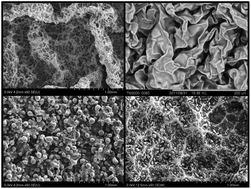Surfactant sculpting of biologically inspired hierarchical surfaces†
Abstract
We describe a method for fabricating biologically inspired hierarchical surfaces in a single step through surfactant self-assembly at an oil/water interface. The key to this system is the use of polydimethylsiloxane-diacrylate for the oil phase, which makes it possible to solidify these delicate structures with UV photocuring. Scanning electron microscopy (SEM) and 3-D optical profilometry reveals morphologies that capture the randomness, fractal geometry, and hierarchical organization of natural materials. The morphology is controlled by surfactant type, surfactant concentration, viscosity, film thickness, and time. The experimental evidence is consistent with a spontaneous increase in surface area driven by a transiently negative surface tension. Spontaneous emulsification generates distinct morphologies for a given surfactant and surfactant concentration in a manner reminiscent of phase behavior in a ternary phase diagram. When emulsification cannot keep pace with the increase in surface area, buckles form. These perturbations are then amplified at increasing length scales by dewetting and the Rayleigh–Taylor instability.


 Please wait while we load your content...
Please wait while we load your content...